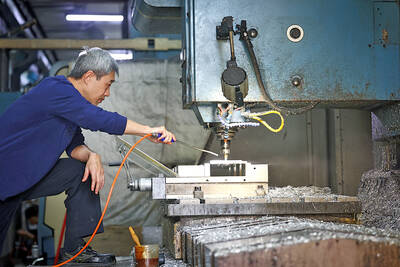Samsung Electronics Co on Wednesday unveiled its newest Galaxy S25 smartphones, powered by Qualcomm’s chips and Google’s artificial intelligence (AI) model, hoping its upgraded AI features can reinvigorate sales and fend off Apple Inc and Chinese rivals.
Samsung also previewed a thinner version of the flagship models at the end of an event in California, aiming to launch the Galaxy S25 Edge in the first half of this year ahead of Apple’s anticipated rollout of its slimmer iPhone.
Samsung was faster than Apple in launching an AI-powered smartphone, but failed to regain its crown in the global smartphone market last year, squeezed by competition with the US rival in the premium market and with Chinese firms in the lower-end segment.

Photo: Bloomberg
“We are one step ahead of the industry in terms of offering AI features. I believe we are going in the right direction,” said Park Ji-sun, the executive vice president who leads Samsung’s Language AI team.
Samsung kept the prices of its Galaxy S25 series unchanged at between US$799 and US$1,299.
The new Galaxy S25 uses Gemini offered by Alphabet’s Google as its default AI engine and features Samsung’s upgraded in-house voice assistant, Bixby, Park said.
The two tools complement each other and Bixby plays a key role at Samsung, whose products span mobile phones to TVs and home appliances, he said.
Thomas Husson, an analyst at Forrester, said that differentiating Bixby would be a challenge for Samsung.
“I don’t think there is really a killer application today that you know would convince them [consumers]: ‘OK, I’m going to buy this one because it’s an AI smartphone,’” he said.
However, AI features could create a halo effect around the Samsung brand, Husson said.
The Galaxy S25 would offer a more personalized AI experience. For example, its “Now Brief” service — which makes recommendations to users based on personalized data that is stored and processed on the phone for privacy reasons — would display a suite of customized items such as calendars, news and bedroom air temperature and carbon dioxide levels, Park said.
The phone would be able to carry out multiple tasks with a single command, such as finding upcoming sporting events and then adding them to users’ calendars.
Samsung used Qualcomm’s Snapdragon 8 Elite Mobile Platform for the entire Galaxy S25 lineup, ditching its own mobile chip Exynos, a major change of strategy for a company that previously used both to have more bargaining power with suppliers.
Using a Qualcomm chip is a setback to the South Korean firm’s chip business, which counts its mobile division as one of its major customers.
A person familiar with the matter said that Samsung is looking to use the Exynos chip in its foldable phones to be launched later this year.
“The Galaxy S25 series’ sale is important at a time when Samsung’s foldable phone sales have been stagnating in the face of challenges from Chinese companies,” said Lim Su-jeong, associate director at research firm Counterpoint.
Samsung’s preliminary fourth-quarter profit, released earlier this month, missed estimates by a large margin due to chip development costs and rising competition in the smartphone market.

SEEKING CLARITY: Washington should not adopt measures that create uncertainties for ‘existing semiconductor investments,’ TSMC said referring to its US$165 billion in the US Taiwan Semiconductor Manufacturing Co (TSMC, 台積電) told the US that any future tariffs on Taiwanese semiconductors could reduce demand for chips and derail its pledge to increase its investment in Arizona. “New import restrictions could jeopardize current US leadership in the competitive technology industry and create uncertainties for many committed semiconductor capital projects in the US, including TSMC Arizona’s significant investment plan in Phoenix,” the chipmaker wrote in a letter to the US Department of Commerce. TSMC issued the warning in response to a solicitation for comments by the department on a possible tariff on semiconductor imports by US President Donald Trump’s

The government has launched a three-pronged strategy to attract local and international talent, aiming to position Taiwan as a new global hub following Nvidia Corp’s announcement that it has chosen Taipei as the site of its Taiwan headquarters. Nvidia cofounder and CEO Jensen Huang (黃仁勳) on Monday last week announced during his keynote speech at the Computex trade show in Taipei that the Nvidia Constellation, the company’s planned Taiwan headquarters, would be located in the Beitou-Shilin Technology Park (北投士林科技園區) in Taipei. Huang’s decision to establish a base in Taiwan is “primarily due to Taiwan’s talent pool and its strength in the semiconductor

Industrial production expanded 22.31 percent annually last month to 107.51, as increases in demand for high-performance computing (HPC) and artificial intelligence (AI) applications drove demand for locally-made chips and components. The manufacturing production index climbed 23.68 percent year-on-year to 108.37, marking the 14th consecutive month of increase, the Ministry of Economic Affairs said. In the first four months of this year, industrial and manufacturing production indices expanded 14.31 percent and 15.22 percent year-on-year, ministry data showed. The growth momentum is to extend into this month, with the manufacturing production index expected to rise between 11 percent and 15.1 percent annually, Department of Statistics

An earnings report from semiconductor giant and artificial intelligence (AI) bellwether Nvidia Corp takes center stage for Wall Street this week, as stocks hit a speed bump of worries over US federal deficits driving up Treasury yields. US equities pulled back last week after a torrid rally, as investors turned their attention to tax and spending legislation poised to swell the US government’s US$36 trillion in debt. Long-dated US Treasury yields rose amid the fiscal worries, with the 30-year yield topping 5 percent and hitting its highest level since late 2023. Stocks were dealt another blow on Friday when US President Donald